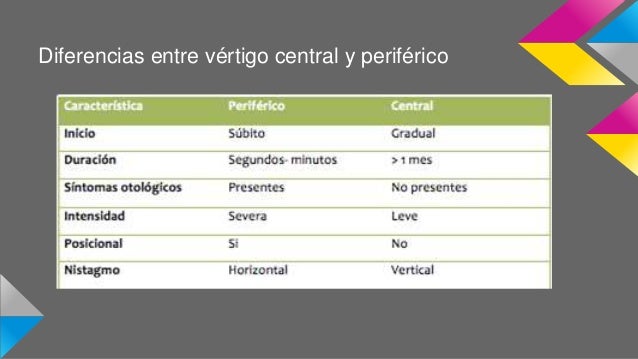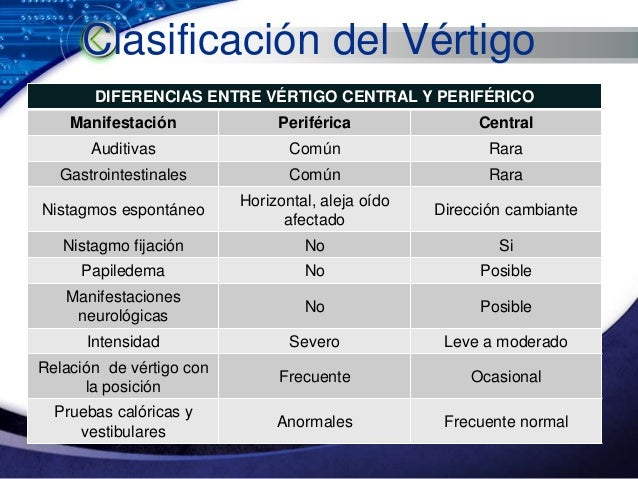
you are a senior with history of past falls or fear of falling.
#QUE ES VERTIGO PROFESSIONAL#
You might be sent to a health professional (medical provider, audiologist or therapist) who can perform these maneuvers, especially if you have any of the following: They can be done at the same time the bedside testing for diagnosis is being performed. These maneuvers are designed to guide the crystals back to their original location in your inner ear. They have high success rates (around 80%) although sometimes the treatment needs to be repeated a few times. Although medications are not used other than for relief of immediate distress, such as nausea, most BPPV cases can be corrected with bedside repositioning exercises that usually take only a few minutes to complete. The most common tests are called the Dix-Hallpike test or supine roll test. The examiner will be watching you for a certain eye movement to confirm your diagnosis. The testing may include hanging your head a little off the edge of the bed or rolling your head left and right while lying in bed. The bedside testing requires the examiner to move your head into a position that makes the crystals move and will make you dizzy. Your health care provider or examiner will complete simple bedside testing to help to confirm your diagnosis. Q: How is BPPV diagnosed? A: Normal medical imaging, such as scans and X-rays, or medical laboratory testing cannot confirm BPPV. It can sometimes be associated with trauma, migraine, other inner ear problems, diabetes, osteoporosis, and lying in bed for long periods of time (preferred sleep side, surgical procedures, illness). Q: What caused my BPPV? A: Most cases of BPPV happen for no reason. Many of us will experience it at some time in our lives. Q: How common is BPPV? A: BPPV is very common. People will often report that their very first BPPV spinning episode was the worst and the following episodes were not as bad.

The natural course of BPPV is to become less severe over time. BPPV does not affect your hearing or cause you to faint. BPPV does not cause constant severe dizziness and is usually triggered by movement. In some people, especially seniors, BPPV can appear as an isolated sense of instability brought on by position change like sitting up, looking up, bending over and reaching. You can have lasting feelings of dizziness and instability, but at a lesser level, once the episode has passed. These symptoms will be intense for seconds to minutes. You may also feel unstable or like you are losing your balance. You may experience nausea (sometimes vomiting) and/or a severe sense of disorientation in space. The most common symptoms are distinct triggered spells of vertigo or spinning sensations. Q: What are the common symptoms and how can BPPV affect me? A: Everyone will experience BPPV differently, but there are common symptoms. As the crystals move and settle, your brain is getting powerful (false) messages telling you that you are violently spinning when all you may have done is laid down or rolled over in bed. The most intense part of your BPPV symptoms have to do with how long it takes the crystals or sensor to settle after you move or change your head or body position.

They begin to float around and/or get stuck on sensors in the wrong part or wrong canal of the inner ear. BPPV is caused by the crystals becoming “unglued” from their normal place. These tiny rocklike crystals or “otoconia” (oh-toe-cone-ee-uh) are settled in the center “pouch” of the inner ear. Q: What causes BPPV? A: There are crystals of calcium carbonate that are a normal part of our inner ear and help us with our balance and body motion. Vertigo: feeling like you are spinning or the world around you is spinning 1

Positional: certain head positions or movements can trigger a spell Paroxysmal (par-ek-siz-muhl): it comes in sudden, short spells A: Benign Paroxysmal Positional Vertigo (BPPV) is the most common inner ear problem and cause of vertigo, or false sense of spinning.īPPV is a specific diagnosis and each word describes the condition:īenign: it is not life-threatening, even though the symptoms can be very intense and upsetting


 0 kommentar(er)
0 kommentar(er)
